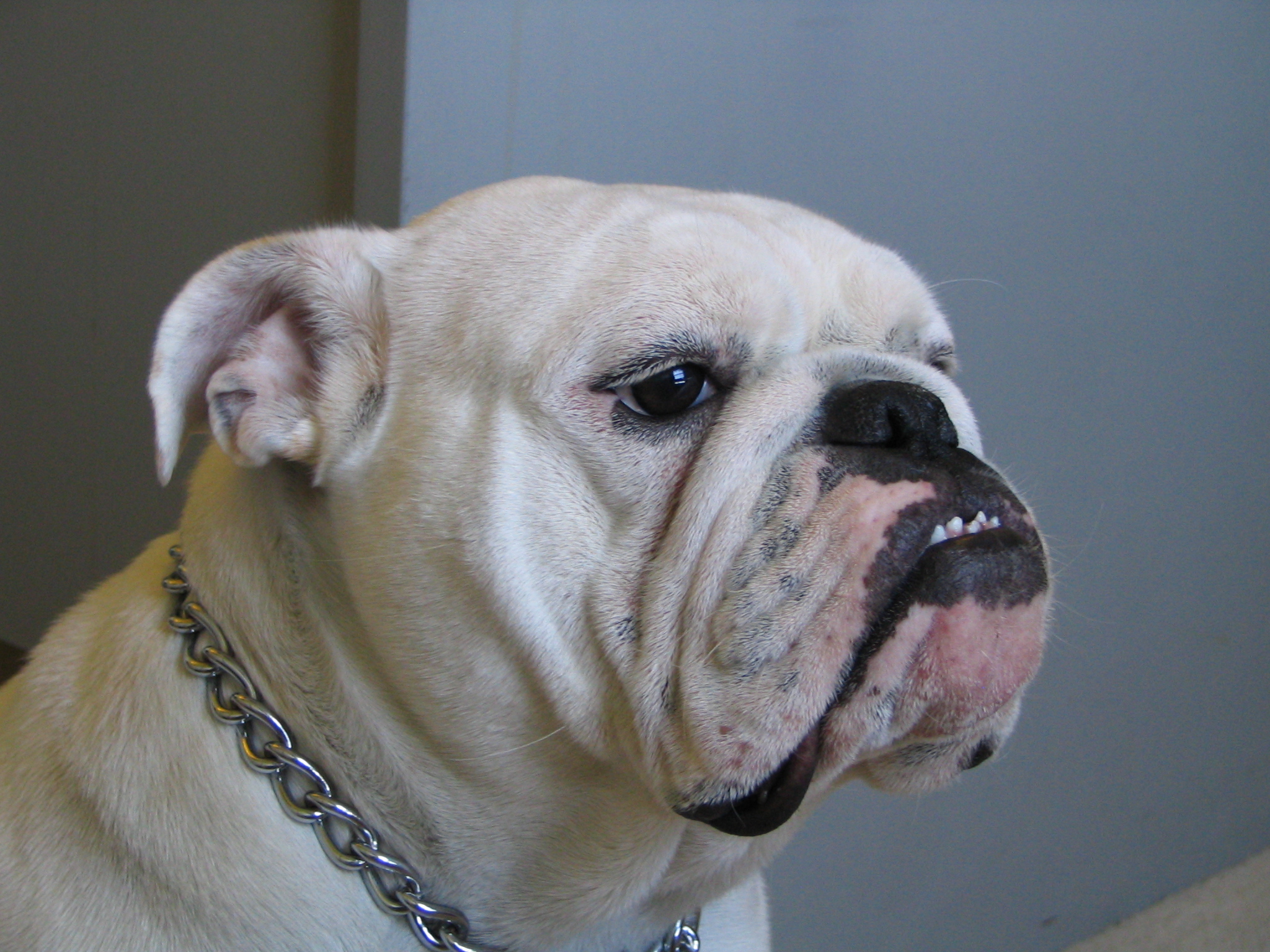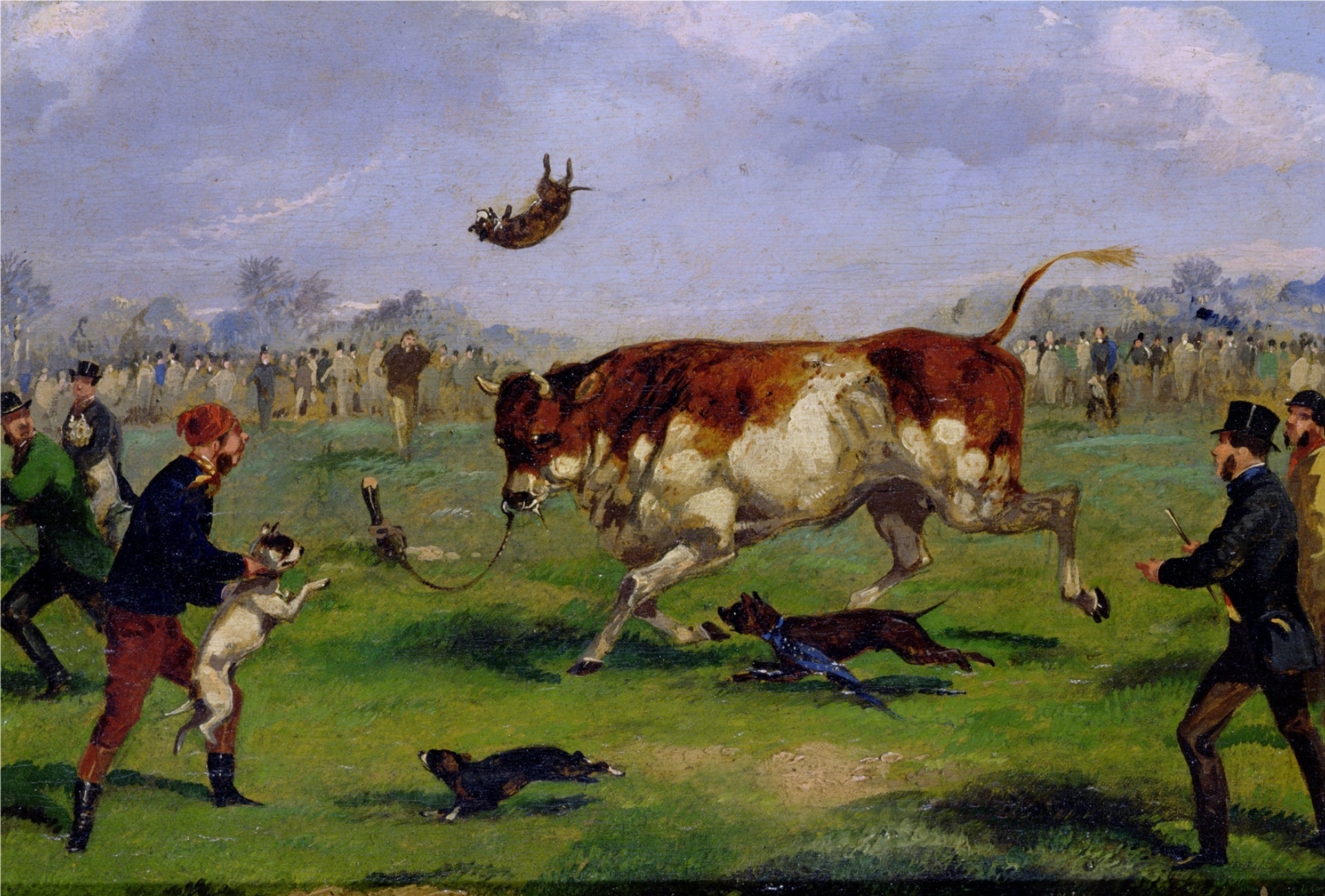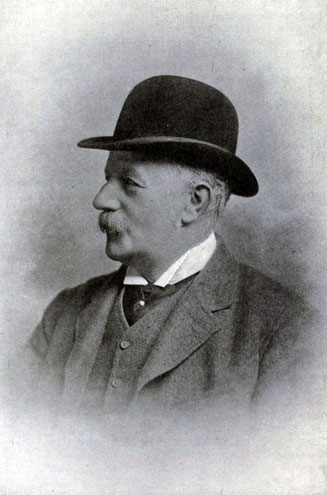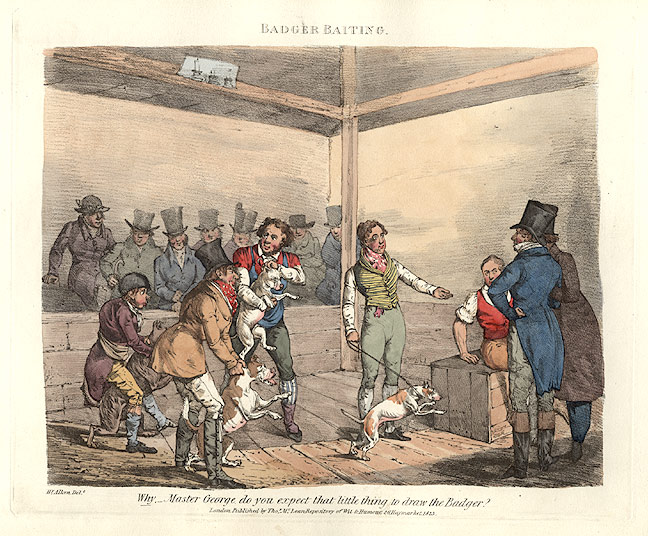|
Bulldog
The Bulldog is a British breed of dog of mastiff type. It may also be known as the English Bulldog or British Bulldog. It is of medium size, a muscular, hefty dog with a wrinkled face and a distinctive pushed-in nose."Get to Know the Bulldog" , 'The American Kennel Club'. Retrieved 29 May 2014 It is commonly kept as a ; in 2013 it was in twelfth place on a list of the breeds most frequently registered worldwide. The Bulldog has a longstanding association with ; the |
Old English Bulldog
The Old English Bulldog is an extinct dog breed, breed of dog. Physical characteristics The Old English Bulldog was compact, broad and muscular, as reflected in the painting ''Crib and Rosa''. Through John Scott's engraving, this painting became the best-known and most reproduced painting of dogs from that period. As described in the Philo-kuon standard from 1865, the average height was approximately , and they weighed about . History The English people, English blood sport of bull-baiting allowed for a specialized breed in the form of the Old English Bulldog. The main locations in London for these exhibitions were the Westminster Pit, Beargarden and Old Conduit Fields. Breeding Historians are fairly confident that the Old English Bulldog is derived from ancient war dogs, such as the old English Mastiff, Mastiff or the extinct Alaunt dog. Others believe that the true origin of the breed is not entirely clear. Depictions in old prints show that the variety was withou ... [...More Info...] [...Related Items...] OR: [Wikipedia] [Google] [Baidu] |
Mastiff
A mastiff is a large and powerful type of dog. Mastiffs are among the largest dogs, and typically have a short coat, a long low-set tail and large feet; the skull is large and bulky, the muzzle broad and short (brachycephalic) and the ears drooping and pendant-shaped. European and Asian records dating back 3,000 years show dogs of the mastiff type. Mastiffs have historically been guard dogs, protecting homes and property, although throughout history they have been used as hunting dogs, war dogs and for blood sports, such as fighting each other and other animals, including bulls, bears and even lions. Historical and archaeological evidence suggests that mastiffs have long been distinct in both form and function from the similarly large livestock guardian dogs from which they were most likely developed; they also form separate genetic populations. The Fédération Cynologique Internationale and some kennel clubs group the two types together as molossoid dogs; some modern livest ... [...More Info...] [...Related Items...] OR: [Wikipedia] [Google] [Baidu] |
Bill George (dog Dealer)
Bill George (1802–1881) was a Victorian era dog dealer and well-known character in London, England. Early life George's first job was as a butcher's boy. A bareknuckle prizefighter, he later became an apprentice to Ben White of 'May Tree Cottage', Kensal New Town, a dealer of Old English Bulldogs, the ancestral breed of Bulldog used for dog fighting and bull-baiting. Kensal New Town was a rough working class area with many Irish immigrants and the scene of Protestant-Catholic conflicts. He was indirectly part of an incident in 1825, sponsored by Sam Wedgbury, who had bought a dog from White, and a menagerie owner called George Wombwell, involving lion-baiting by Bulldogs. George is said to have unsuccessfully attempted to dissuade the participants from continuing in this bloody enterprise. The outcome was that one of the lions was injured and several dogs were killed, leading to public outrage and a local ordinance banning the use of dogs for fighting. The practice continued in ... [...More Info...] [...Related Items...] OR: [Wikipedia] [Google] [Baidu] |
Bull-baiting
Bull-baiting is a blood sport involving pitting a bull against dogs. History England Crowds in London during the Royal Entry of James VI and I in March 1604 were entertained by bull-baiting. During the time of Queen Anne, bull-baiting was practised in London at Hockley-in-the-Hole, twice a week – and was also reasonably common in provincial towns, for instance at Birmingham's Bull Ring. At Tutbury, a bull was tied to an iron stake so that it could move within a radius of about 30 feet. The object of the sport was for the dogs to immobilize the bull. Before the event started, the bull's nose was blown full of pepper to enrage it before the baiting. The bull was often placed in a hole in the ground. A variant of bull-baiting was "pinning the bull", where specially-trained dogs would set upon the bull one at a time, a successful attack resulting in the dog fastening his teeth strongly in the bull's snout. The extinct Old English Bulldog was specially bred for this sport ... [...More Info...] [...Related Items...] OR: [Wikipedia] [Google] [Baidu] |
Culture Of The United Kingdom
British culture is influenced by History of the United Kingdom, the combined nations' history; its historically Christianity, Christian Religion in the United Kingdom, religious life, its interaction with the cultures of Europe, the traditions of England, Wales, Scotland and Ireland and the impact of the British Empire. Although British culture is a distinct entity, the individual Culture of England, cultures of England, Culture of Scotland, Scotland, Culture of Wales, Wales and Culture of Northern Ireland, Northern Ireland are diverse and have varying degrees of overlap and distinctiveness. British literature is particularly esteemed. The modern novel was invented in Britain, and playwrights, poets, and authors are among its most prominent cultural figures. Britain has also made notable contributions to Music of the United Kingdom, music, British cinema, cinema, Art of the United Kingdom, art, Architecture of the United Kingdom, architecture and Television in the United Kingdom, ... [...More Info...] [...Related Items...] OR: [Wikipedia] [Google] [Baidu] |
The Kennel Club
The Kennel Club ("KC") is the official kennel club of the United Kingdom. It is the oldest recognised kennel club in the world. Its role is to oversee various canine activities including dog shows, dog agility and working trials. It also operates the national register of pedigree dogs in the United Kingdom and acts as a lobby group on issues involving dogs in the UK. Its headquarters are on Clarges Street in Mayfair, London, with business offices in Aylesbury. The Kennel Club registration system divides dogs into seven breed groups. The Kennel Club Groups are: Hound group, Working group, Terrier group, Gundog group, Pastoral group, Utility group and Toy group. As of 2021, The Kennel Club recognised 222 breeds of dog. The Kennel Club licenses dog shows throughout the UK, but the only dog show it actually runs is Crufts. The show has been held since 1928 and attracts competitors from all over the world. It is held every March at the NEC, Birmingham, and includes the less for ... [...More Info...] [...Related Items...] OR: [Wikipedia] [Google] [Baidu] |
Bear-baiting
Bear-baiting is a blood sport in which a chained bear and one or more dogs are forced to fight one another. It may also involve pitting a bear against another animal. History Europe Great Britain Bear-baiting was very popular from the 12th until the 19th century. From the sixteenth century, many bears were maintained for baiting. In its best-known form, arenas for this purpose were called bear-gardens, consisting of a circular high fenced area, the " pit", and raised seating for spectators. A post would be set in the ground towards the edge of the pit and the bear chained to it, either by the leg or neck. Several well-trained fighting or baiting dogs, usually Old English Bulldogs, would then be set on it, being replaced as they got tired or were wounded or killed. In some cases the bear was let loose, allowing it to chase after animals or people. For a long time, the main bear-garden in London was the Paris Garden, a section of the Bankside lying to the west of The Clink, a ... [...More Info...] [...Related Items...] OR: [Wikipedia] [Google] [Baidu] |
Cruelty To Animals Act 1835
The Cruelty to Animals Act 1835 was an Act of the Parliament of the United Kingdom (5 & 6 Will. 4, c. 59), intended to protect animals, and in particular cattle, from mistreatment. Its long title is An Act to Consolidate and Amend the Several Laws Relating to the Cruel and Improper Treatment of Animals, and the Mischiefs Arising from the Driving of Cattle, and to Make Other Provisions in Regard Thereto. Passage The Act was introduced as a bill by the member of parliament for South Durham, Joseph Pease, who was a Quaker and a member of the committee of the Society for the Prevention of Cruelty to Animals. The law was passed in part due to lobbying by the Society (founded 1824, since 1840 the RSPCA). The Act was repealed and replaced by the Cruelty to Animals Act 1849 12 & 13 Vict. c. 92. Animal baiting The British legal action to protect animals began with the passing of the Cruel Treatment of Cattle Act 1822 to Prevent Cruel and Improper Treatment of Cattle.''The Rights of ... [...More Info...] [...Related Items...] OR: [Wikipedia] [Google] [Baidu] |
Snake
Snakes are elongated, Limbless vertebrate, limbless, carnivore, carnivorous reptiles of the suborder Serpentes . Like all other Squamata, squamates, snakes are ectothermic, amniote vertebrates covered in overlapping Scale (zoology), scales. Many species of snakes have skulls with several more joints than their lizard ancestors, enabling them to swallow prey much larger than their heads (cranial kinesis). To accommodate their narrow bodies, snakes' paired organs (such as kidneys) appear one in front of the other instead of side by side, and most have only one functional lung. Some species retain a pelvic girdle with a pair of vestigial claws on either side of the cloaca. Lizards have evolved elongate bodies without limbs or with greatly reduced limbs about twenty-five times independently via convergent evolution, leading to many lineages of legless lizards. These resemble snakes, but several common groups of legless lizards have eyelids and external ears, which snakes lack, altho ... [...More Info...] [...Related Items...] OR: [Wikipedia] [Google] [Baidu] |
Donkey
The domestic donkey is a hoofed mammal in the family Equidae, the same family as the horse. It derives from the African wild ass, ''Equus africanus'', and may be classified either as a subspecies thereof, ''Equus africanus asinus'', or as a separate species, ''Equus asinus''. It was domesticated in Africa some years ago, and has been used mainly as a working animal since that time. There are more than 40 million donkeys in the world, mostly in underdeveloped countries, where they are used principally as draught or pack animals. While working donkeys are often associated with those living at or below subsistence, small numbers of donkeys or asses are kept for breeding or as pets in developed countries. A male donkey is known as a ''jack'' or ''jackass'', a female is a ''jenny'' or ''jennet'', and an immature donkey of either sex is a '' foal''. Jacks are often mated with female horses (mares) to produce '' mules''; the less common hybrid of a male horse (stallion) and j ... [...More Info...] [...Related Items...] OR: [Wikipedia] [Google] [Baidu] |
England
England is a country that is part of the United Kingdom. It shares land borders with Wales to its west and Scotland to its north. The Irish Sea lies northwest and the Celtic Sea to the southwest. It is separated from continental Europe by the North Sea to the east and the English Channel to the south. The country covers five-eighths of the island of Great Britain, which lies in the North Atlantic, and includes over 100 smaller islands, such as the Isles of Scilly and the Isle of Wight. The area now called England was first inhabited by modern humans during the Upper Paleolithic period, but takes its name from the Angles, a Germanic tribe deriving its name from the Anglia peninsula, who settled during the 5th and 6th centuries. England became a unified state in the 10th century and has had a significant cultural and legal impact on the wider world since the Age of Discovery, which began during the 15th century. The English language, the Anglican Church, and Engli ... [...More Info...] [...Related Items...] OR: [Wikipedia] [Google] [Baidu] |
Cockfighting
A cockfight is a blood sport, held in a ring called a cockpit. The history of raising fowl for fighting goes back 6,000 years. The first documented use of the ''word'' gamecock, denoting use of the cock as to a "game", a sport, pastime or entertainment, was recorded in 1634, after the term "cock of the game" used by George Wilson, in the earliest known book on the sport of cockfighting in ''The Commendation of Cocks and Cock Fighting'' in 1607. But it was during Magellan's voyage of discovery of the Philippines in 1521 when modern cockfighting was first witnessed and documented for Westerners by the Italian Antonio Pigafetta, Magellan's chronicler, in the Kingdom of Taytay. The combatants, referred to as gamecocks (not to be confused with game birds), are specially bred and conditioned for increased stamina and strength. Male and female chickens of such a breed are referred to as game fowl. Cocks possess congenital aggression toward all males of the same species. Wagers are ... [...More Info...] [...Related Items...] OR: [Wikipedia] [Google] [Baidu] |






.jpg)



.jpg)